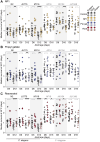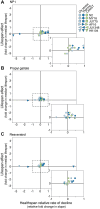The coupling between healthspan and lifespan in Caenorhabditis depends on complex interactions between compound intervention and genetic background
- PMID: 38613792
- PMCID: PMC11042945
- DOI: 10.18632/aging.205743
The coupling between healthspan and lifespan in Caenorhabditis depends on complex interactions between compound intervention and genetic background
Abstract
Aging is characterized by declining health that results in decreased cellular resilience and neuromuscular function. The relationship between lifespan and health, and the influence of genetic background on that relationship, has important implications in the development of pharmacological anti-aging interventions. Here we assessed swimming performance as well as survival under thermal and oxidative stress across a nematode genetic diversity test panel to evaluate health effects for three compounds previously studied in the Caenorhabditis Intervention Testing Program and thought to promote longevity in different ways - NP1 (nitrophenyl piperazine-containing compound 1), propyl gallate, and resveratrol. Overall, we find the relationships among median lifespan, oxidative stress resistance, thermotolerance, and mobility vigor to be complex. We show that oxidative stress resistance and thermotolerance vary with compound intervention, genetic background, and age. The effects of tested compounds on swimming locomotion, in contrast, are largely species-specific. In this study, thermotolerance, but not oxidative stress or swimming ability, correlates with lifespan. Notably, some compounds exert strong impact on some health measures without an equally strong impact on lifespan. Our results demonstrate the importance of assessing health and lifespan across genetic backgrounds in the effort to identify reproducible anti-aging interventions, with data underscoring how personalized treatments might be required to optimize health benefits.
Keywords: aging; compound intervention; genetic diversity; healthspan.
Conflict of interest statement
Figures





Similar articles
-
The resveratrol derivatives trans-3,5-dimethoxy-4-fluoro-4'-hydroxystilbene and trans-2,4',5-trihydroxystilbene decrease oxidative stress and prolong lifespan in Caenorhabditis elegans.J Pharm Pharmacol. 2017 Jan;69(1):73-81. doi: 10.1111/jphp.12657. Epub 2016 Nov 23. J Pharm Pharmacol. 2017. PMID: 27882602 Free PMC article.
-
Blueberry polyphenols increase lifespan and thermotolerance in Caenorhabditis elegans.Aging Cell. 2006 Feb;5(1):59-68. doi: 10.1111/j.1474-9726.2006.00192.x. Aging Cell. 2006. PMID: 16441844 Free PMC article.
-
Metformin treatment of diverse Caenorhabditis species reveals the importance of genetic background in longevity and healthspan extension outcomes.Aging Cell. 2022 Jan;21(1):e13488. doi: 10.1111/acel.13488. Epub 2021 Nov 27. Aging Cell. 2022. PMID: 34837316 Free PMC article.
-
Pharmacology of delayed aging and extended lifespan of Caenorhabditis elegans.Exp Gerontol. 2006 Oct;41(10):1032-9. doi: 10.1016/j.exger.2006.06.038. Epub 2006 Jul 26. Exp Gerontol. 2006. PMID: 16872777 Review.
-
A Critical Review of the Evidence That Metformin Is a Putative Anti-Aging Drug That Enhances Healthspan and Extends Lifespan.Front Endocrinol (Lausanne). 2021 Aug 5;12:718942. doi: 10.3389/fendo.2021.718942. eCollection 2021. Front Endocrinol (Lausanne). 2021. PMID: 34421827 Free PMC article. Review.
Cited by
-
Stochasticity in Dietary Restriction-Mediated Lifespan Outcomes in Drosophila.Res Sq [Preprint]. 2024 Sep 17:rs.3.rs-4876799. doi: 10.21203/rs.3.rs-4876799/v1. Res Sq. 2024. PMID: 39372939 Free PMC article. Preprint.
-
Stochasticity in Dietary Restriction-Mediated Lifespan Outcomes in Drosophila.bioRxiv [Preprint]. 2024 Sep 12:2024.09.06.611756. doi: 10.1101/2024.09.06.611756. bioRxiv. 2024. PMID: 39314308 Free PMC article. Preprint.
-
Considering Caenorhabditis elegans Aging on a Temporal and Tissue Scale: The Case of Insulin/IGF-1 Signaling.Cells. 2024 Feb 5;13(3):288. doi: 10.3390/cells13030288. Cells. 2024. PMID: 38334680 Free PMC article. Review.
-
Antioxidants green tea extract and nordihydroguaiaretic acid confer species and strain-specific lifespan and health effects in Caenorhabditis nematodes.Geroscience. 2024 Apr;46(2):2239-2251. doi: 10.1007/s11357-023-00978-0. Epub 2023 Nov 4. Geroscience. 2024. PMID: 37923874 Free PMC article.
-
Mitophagy-promoting agents and their ability to promote healthy-aging.Biochem Soc Trans. 2023 Oct 31;51(5):1811-1846. doi: 10.1042/BST20221363. Biochem Soc Trans. 2023. PMID: 37650304 Free PMC article.
References
-
- Glenn CF, Chow DK, David L, Cooke CA, Gami MS, Iser WB, Hanselman KB, Goldberg IG, Wolkow CA. Behavioral deficits during early stages of aging in Caenorhabditis elegans result from locomotory deficits possibly linked to muscle frailty. J Gerontol A Biol Sci Med Sci. 2004; 59:1251–60. 10.1093/gerona/59.12.1251 - DOI - PMC - PubMed
Publication types
MeSH terms
Substances
Grants and funding
LinkOut - more resources
Full Text Sources

